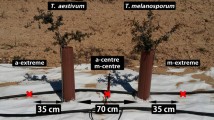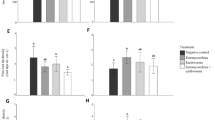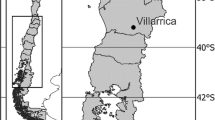Abstract
Interest in conversion of marginal agricultural lands to small oak woodlands for the production of black truffles (Tuber melanosporum Vittad.) is increasing in the native black truffle areas of France, Spain and Italy as well as suitable or amended sites throughout the world due to high economic returns for gastronomically valuable truffles. Successful long-term management of a perennial plantation replacing an annual crop requires understanding the system in all phases of the life cycle, and in the case of truffles this involves understanding the interactive growth of the aboveground host and the belowground symbiotic ectomycorrhizal fungus whose fruitbody is the desired truffle. Here we focus on the pre-production phase, 4 years after establishing the truffle-oak plantation and prior to truffle production. We tested the influence of weed control, irrigation and fertilizer, each at 3 levels, on plant growth and ectomycorrhizal proliferation in three truffle-oaks plantations in northeast Spain. Results show that adequate weed control improves root and shoot dry weight while fertilizer and irrigation treatments did not influence plant growth. The low dose of irrigation (50% of the estimated water deficit for the site) and glyphosate weed control both increased total root tips/plant and T. melanosporum colonized tips (ectomycorrhizae) by approximately two-fold, compared to control treatments. Distribution of the ectomycorrhizae within the soil profile was significantly influenced by the low dose irrigation treatment, with increases observed in the 10–20 cm and the 20–30 cm deep layers compared to the control and high irrigation treatments. Four years after planting, T. melanosporum remained the dominant fungal symbiont, despite the presence of 14 other ectomycorrhizal morphotypes from these sites.




Similar content being viewed by others
References
Bocio I, Navarro FB, Ripoll MA, Jiménez MN, De Simón E (2004) Holm oak (Quercus rotundifolia Lam.) and Aleppo pine (Pinus halepensis Mill.) response to different soil preparation techniques applied to forestation in abandoned farmland. Ann For Sci 61:171–178. doi:10.1051/forest:2004009
Bonet JA, Fischer CR, Colinas C (2006) Cultivation of black truffle to promote reforestation and land-use stability. Agron Sustain Dev 26:69–76. doi:10.1051/agro:2005059
Busse MD, Fiddler GO, Ratcliff AW (2004) Ectomycorrhizal formation in herbicide-treated soils of differing clay and organic matter content. Water Air Soil Poll 152:23–34
Cahill JF Jr (1999) Fertilization effects on interactions between above-and belowground competition in an old field. Ecology 80:466–480
Canadell J, Djema A, López B, Lloret F, Sabaté S, Siscart D, Gracia CA (1999) Structure and dynamics of the root system. In: Rodà F, Retana J, Gracia CA, Bellot J (eds) Ecology of Mediterranean evergreen oak forests. Springer, New York, pp 47–59
Chakravarty P, Chatarpaul L (1990a) Non-targeteffect of herbicides I. The influence of gyphosate on ectomycorrhizal symbiosis of red pine (Pinus resinosa) under greenhouse and field conditions. Pesticide Sci 28:233–241
Chakravarty P, Chatarpaul L (1990b) Non-Targeteffect of herbicides II. The influence of gyphosate on ectomycorrhizal symbiosis of red pine (Pinus resinosa) under greenhouse and field conditions. Pesticide Sci 28:243–247
Dixon RK, Garrett HE, Bixby JA, Cox GS, Tompson JG (1981) Growth, ectomycorrhizal development, and root soluble carbohydrates of black oak seedlings fertilized by two methods. For Sci 27:617–624
Domínguez Núñez JA, Serrano JS, Barreal JAR, González JAS (2006) The influence of mycorrhization with Tuber melanosporum in the afforestation of a mediterranean site with Quercus ilex and Quercus faginea. For Ecol Manag 231:226–233. doi:10.1016/j.foreco.2006.05.052
Eichhorn MP, Paris P, Herzog F, Incoll LD, Liagre F, Mantzanas K, Mayus M, Moreno G, Papanastasis VP, Pilbeam DJ (2006) Silvoarable systems in Europe–past, present and future prospects. Agrofor Syst 67:29–50. doi:10.1007/s10457-005-1111-7
El Omari B, Aranda X, Verdaguer D, Pascual G, Fleck I (2003) Resource remobilization in Quercus ilex L. resprouts. Plant Soil 252:349–357
Fischer CR, Colinas C (1996) Methodology for certification of Quercus ilex seedlings inoculated with Tuber melanosporum for commercial application. Proceedings of the 1st international conference in Mycorrhizae, Berkeley
Gracia C, Sabaté S, López B, Sánchez A (2000) Presente y futuro del bosque mediterráneo: balance de carbono, gestión forestal y cambio global. Simposio de la Sociedad Española de Ecología Terrestre, Granada
Hall IR, Brown GT, Zambonelli A (2007) Taming the truffle: the history, lore and science of the ultimate mushroom. Timber Press Inc, Portland
Lulli L, Bragato G, Gardin L (1999) Occurrence of Tuber melanosporum in relation to soil surface layer properties and soil differentiation. Plant Soil 214:85–92
Mamoun M, Olivier JM (1993) Competition between Tuber melanosporum and other ectomycorrhizal fungi under two irrigation regimes I. Plant Soil 149:211–218
Mamoun M, Olivier JM (1997) Mycorrhizal inoculation of cloned hazels by Tuber melanosporum: effect of soil disinfestation and co-culture with Festuca ovina. Plant Soil 188:221–226
Marsh BB (1971) Measurement of length in random arrangements of lines. J Appl Ecol 8:265–267
Napoli C, Mello A, Borra A, Vizzini A, Sourzat P, Bonfante P (2010) Tuber melanosporum, when dominant, affects fungal dynamics in truffle grounds. New Phytol 185:237–247. doi:10.1111/j.1469-8137.2009.03053.x
Navarro Cerrillo RM, Fragueiro B, Ceaceros C, del Campo A, de Prado R (2005) Establishment of Quercus ilex L. subsp. ballota [Desf.] Samp. using different weed control strategies in Southern Spain. Ecol Eng 25:332–342. doi:10.1016/j.ecoleng.2005.06.002
Nehls U, Grunze N, Willmann M, Reich M, Kuster H (2007) Sugar for my honey: carbohydrate partitioning in ectomycorrhizal symbiosis. Phytochemistry 68:82–91. doi:10.1016/j.phytochem.2006.09.024
Olivier JM, Savignac JC, Sourzat P (2002) Gloire de la truffe et mystères de la trufficulture. In: Olivier JM, Savignac JC, Sourzat P (eds) Truffe et trufficulture, Fanlac. Périgueux pp 15–27
Ramsey F, Schafer D (2002) The Statistical sleuth: a course in methods of data analysis. 2nd edn. Duxbury Press
Rauscher T, Chevalier G (1995) Tuber melanosporum, Colour Atlas of Ectomycorrhizae. Einhorn-Verlag, Schwabisch Gmund
Rey Benayas JM, Espigares T, Castro-Díez P (2003) Simulated effects of herb competition on planted Quercus faginea seedlings in Mediterranean abandoned cropland. Appl Veg Sci 6:213–222
Ricard JM, Bergougnoux F, Callot G, Oliver JM, Pargney JC, Sourzat P (2003) La truffe. Guide technique de trufficulture. Centre technique interprofessionnel des fruits et légumes, Paris
Riccioni C, Belfiori B, Rubini A, Passeri V, Arcioni S, Paolocci F (2008) Tuber melanosporum outcrosses: analysis of the genetic diversity within and among its natural populations under this new scenario. New Phytol 180:466–478. doi:10.1111/j.1469-8137.2008.02560.x
Suz LM, Martin MP, Fischer CR, Bonet JA, Colinas C (2009) Can NPK fertilizers enhance seedling growth and mycorrhizal status of Tuber melanosporum-inoculated Quercus ilex seedlings? Mycorrhiza. doi:10.1007/s00572-009-0289-3
Thornwaite CW, Mather JR (1957) Instructions and Tables for computing potential evapotranspiration and the water balance. Publications in Climatology 10. Centerton, pp 181–311
Treseder KK (2004) A meta-analysis of mycorrhizal responses to nitrogen, phosphorus, and atmospheric CO2 in field studies. New Phytol 164:347–355. doi:10.1111/j.1469-8137.2004.01159.x
Acknowledgments
This project was supported in part by the Departament d’Agricultura, Alimentació i Acció Rural and the Departament de Medi Ambient i Habitatge of the Generalitat de Catalunya, and the European Union INTERREG III-A SILVAPYR 2006 project. We wish to thank the owners of the truffle-oak plantations for their collaboration, providing the land and assistance with maintaining the plantations.
Author information
Authors and Affiliations
Corresponding author
Rights and permissions
About this article
Cite this article
Olivera, A., Fischer, C.R., Bonet, J.A. et al. Weed management and irrigation are key treatments in emerging black truffle (Tuber melanosporum) cultivation. New Forests 42, 227–239 (2011). https://doi.org/10.1007/s11056-011-9249-9
Received:
Accepted:
Published:
Issue Date:
DOI: https://doi.org/10.1007/s11056-011-9249-9




